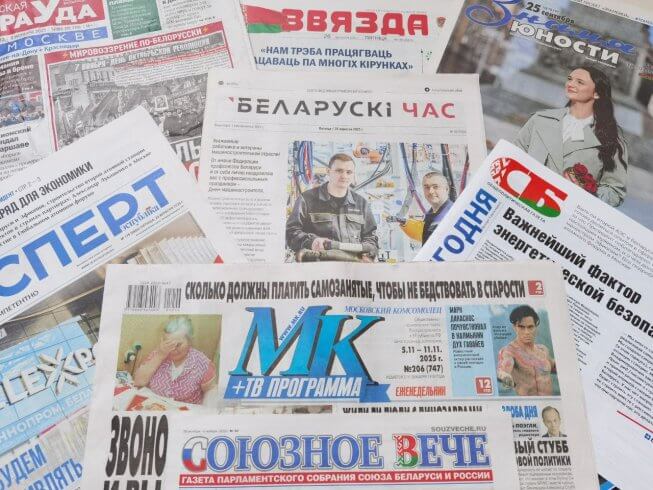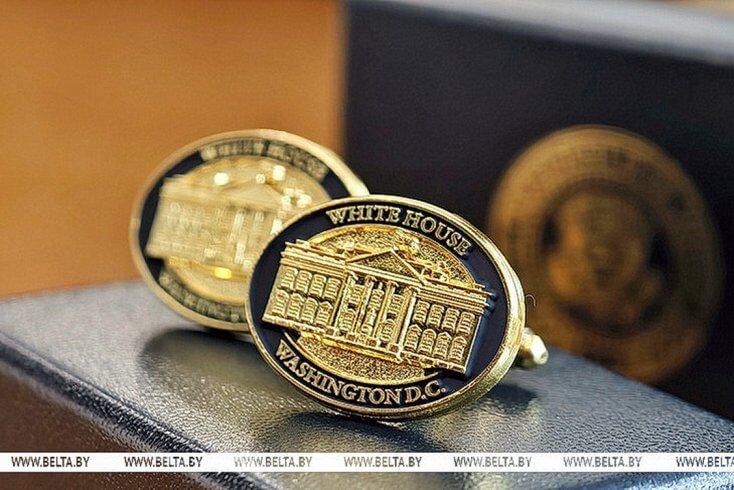On April 9, Alaksandar Łukašenka issued a directive instructing officials to intensify efforts to promote state ideology. The effort is unlikely to make a difference in repressed society.

The document is divided into two parts: a four-page section outlining the ideological “basics,” and a seven-page list of agitation and propaganda measures. That the latter is nearly twice as long comes as no surprise—Łukašenka’s regime lacks a coherent ideology beyond the imperative of self-preservation.
In essence, the directive is an order for officials to indoctrinate citizens into absolute loyalty.
Crackdown on dissent, expansion of loyalty
The directive introduces no novel methods of indoctrination; rather, it reinforces and expands existing practices. Officials are directed to deepen their efforts, particularly in areas such as education, culture, sports, religion and family policy—all of which have been subject to aggressive state control since the 2020 protests. Government agencies and associations have been systematically purged of dissent.
Last month, Łukašenka urged his ministers to continue identifying and eliminating all “enemies of the state who have been lying low for a while.”
Artists, too, are under pressure to show unwavering loyalty. In a meeting with Culture Minister Rusłan Čarniecki, Łukašenka was blunt: “If you are facing some dissent there . . . you must stop it. You are a statesman, and they must be the same as you are.”
The directive instructs a broad spectrum of institutions—including government agencies, educational and cultural bodies, scientific and health organizations, sports clubs, media, political parties and “other economic entities”—to participate in the campaign.
Specific measures include “information and propaganda work,” “prevention of negative informational influence and the dissemination of destructive ideas in society” and instilling ideological and moral values in minors.
The tools are familiar: “dialogue platforms,” official “methodological materials,” and the ubiquitous promotion of state symbols.
One explicit directive concerns censorship: the “assessment of works of art, advertisements, journalistic and entertainment content for compliance with the ideology of the Belarusian state.”
What is new is the requirement that all organizations—public and private—conduct regular political propaganda sessions. This means that Belarusians, already exposed to pervasive propaganda, are likely to face even more intensified ideological messaging in their daily lives.
The basics
The basics section is filled with vague, often banal statements—some of which even opposition leaders might endorse, such as calls for “high-quality healthcare, education and social welfare.”
The authors appear to have struggled with the task of producing a text that signals loyalty without stating the regime’s core principle outright: that Łukašenka is infallible, his policies unimpeachable and his rule permanent. Citizens are left to infer this from between the lines.
The section asserts that Belarus, a successor to the Byelorussian Soviet Socialist Republic, gained “real sovereignty and independence” in 1991 with the establishment of a presidential system [after Łukašenka’s 1994 election].
This claim, however, clashes with the widely held view among political observers that Łukašenka has traded aspects of Belarus’s sovereignty for Russian subsidies and military protection. Notably, he recently admitted that Russian President Vladimir Putin did not even consult him before launching attacks on Ukraine from Belarusian territory.
From a historical perspective, the directive conspicuously omits mention of the 1918 Belarusian People’s Republic, the first independent Belarusian state. Instead, it traces statehood back to the 1917 Bolshevik Revolution and the founding of the Soviet Socialist Republic of Belarus in 1919.
The directive refers to Łukašenka’s system as a “constitutional order” and states that defending it is “the sacred duty and obligation of every Belarusian.” The word democracy is entirely absent from the text. Only once does it mention “the rule of the people,” immediately followed by praise for “the presidential republic as the most optimal system of government.”
Perhaps surprisingly, the document makes no reference to the 2020 political unrest or claims of foreign interference, nor does it credit the national leader with defending Belarus during those events.
One who polarizes a nation cannot unite it
Although the directive is formally addressed to all Belarusians, it will resonate only with those who already support the regime. In today’s polarized Belarusian society, there are effectively three distinct groups.
One Belarus attends state-organized concerts and waves red-green flags. The other keeps a low profile out of fear—sending care packages to imprisoned relatives and keeping in touch with children who fled abroad. One Belarus is content with salaries from state-run enterprises. The other searches for jobs abroad and prepares children for enrollment in foreign universities.
One Belarus watches Belarusian and Russian state television, harbors resentment toward the West and rages against Ukrainian followers of Bandera. The other reads banned media, watches so-called “extremist” YouTube channels and clears its browser history afterward.
Then there is arguably the largest group in between—those who prefer to stay out of politics entirely. They maintain a semblance of normality, sending their kids to school, getting married and starting families. This group is largely indifferent to the regime’s ideological campaigns.
A man who polarizes a nation cannot unite it. Real national consolidation will remain out of reach until a new leader is elected in a free and fair election.




